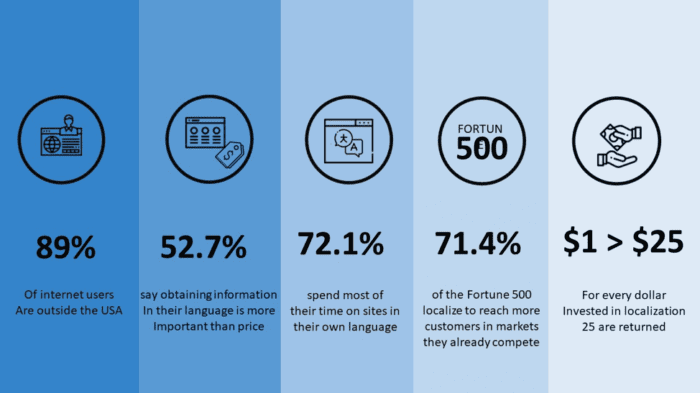Many businesses make the mistake of plunging ahead without due attention to translation quality or write something that proves offensive to the local mindset
Often the most cost-effective way to grow your business is by entering foreign markets. But that's easier said than done. One relatively low-cost key to foreign expansion is successful translation and localization: letting prospective customers know that you speak their language and take into consideration their local culture. We'll consider the challenges and pitfalls of these processes and how to get from here to there most successfully.
It’s a cliché that you don’t get a second chance to make a first impression. But the fact is that many businesses make the mistake of plunging ahead without due attention to translation quality or write something that proves offensive or inappropriate to the local or cultural mindset. The result can be that your message and meaning is “lost in translation” as the Econotimes elucidates.
Download our Business Resource – Website localization guide
The guide is aimed at marketers responsible for increasing the business contribution of companies and brands using customer-facing websites for different international markets.
Access the Website localization guide
It’s not hard to make such linguistic slips without even knowing that you did – until it’s too late. You can’t possibly be an expert on linguistic or cultural nuances in every market but you need to find someone who is, or else risk embarrassment. So what’s the best way to play it safe without laying out wads of cash?
The delicate balance between quality and price
Translating and localizing content are expert services but, for the small business marketer, they can be relatively inexpensive compared to the costs of creating original content. Once you have that original content in hand and seek to use it proactively for marketing to foreign markets, your first step is to devise a localization strategy along with marketing tactics for delivering the translated and localized content to your target audiences.
Whether your content is translating a website or localizing an app, preparing documentation in a foreign language, or performing transcription services, subtitling, voice-overs, or translation/localization services, you need to find the best and most cost-effective sources of linguistic expertise.
Translation managed by your local marketing partner
Let’s start with the high-end of quality – but also price. If you have already engaged a marketing agency in your foreign market, they are likely to either offer translation and localization services or know of an agency or freelancers that can. But watch out: that’s like letting the cat guard the milk. The foreign marketing agency, not you, then controls the localization relations, and you are left needing to trust them, with reduced leverage on quality and cost concerns.
“Trust and verify” is a watchword used by politicians seeking to confirm nuclear deals but it’s also good advice for marketers dealing with foreign marketing partners. At the very least, be part of the decision-making and selection process for localization subcontractors. Review and discuss a shortlist of candidates – never accept a single vendor diktat.
In principle, you can opt to work with a local translation agency, or a freelancer, proposed by your marketing partner. But – it’s a big but – don’t rely on your marketing agency alone. In this case, you will want to seek out and recruit to your side an independent agency with expertise in the language of the target market in question. That agency’s sole job will be to provide quality assurance on translated or localized products, ensuring that your marketing partner, and its subs, are delivering the goods at the required quality level. Where you find such an editing and proofreading partner?
Global translation agencies for marketers
Before we move on to the task of recruiting and managing freelancers to check the work of your primary marketing partner and its subcontractors, there’s another option for you to consider. Instead of relying on a local marketing agency to provide – internally or externally – the linguistic expertise, go instead to a global agency focused exclusively on translation, localization, and other linguistic interpretation services.
There are scores of such agencies a click away on the internet – including (full disclaimer) my own. The key factor to look for in selecting one, naturally, is demonstrable expertise in the target market and its language. Ask for lists of references and examples of successful works.

Facts about localization you should know
Speaking the language of your target market may be the most important factor in growing your audience and increase your new market penetration. The Return on Investment (ROI) can be huge.
Check into the agency’s best practices, and work methods: turnaround time, certifications, pricing policies. A key consideration is whether the translation agency relies primarily on machine translation or smart human translation. Although there has been in recent years a marked improvement in the quality of machine learning (ML), and specifically neural machine language or NML, there is still an advantage to relying on local human beings who still “get” the local language and culture better than any machine (so far!) can.
A translation agency checklist for marketing organizations
Consider the following criteria when selecting a global translation agency partner:
- Response time to your quote requests: it should be measurable in minutes or a few hours, not days!
- Make sure the agency works 24/7 and will guarantee delivery time. Make them put that commitment in writing.
- Dedicated account manager who speaks your language and can work in your preferred time zone. Meet that person (ideally by videoconference) and feel comfortable with that choice, before inking the contract.
- Ensure that the agency has expertise in the specific language pair (yours and the local market).
- Ensure that the agency will guarantee their work for a reasonable period, at least a month up to a year. If you find an error, they should fix it without additional charge.
Managing freelance translators: pros and cons for marketers

Finding and managing freelance translators and localization resources has never been easier. Most marketing managers are probably familiar by now with freelance marketplaces like Fiverr, Freelance.com, and Upwork. You may have used them to get a logo designed, an explainer video produced, a white paper or a landing page designed.
What you may not have considered is using these platforms for getting your content translated to various languages. There is a robust activity in the translation sections of these sites. Just sign up for one or more and post your request, either by briefly describing your project or even, in cases where your content is well-defined and limited in scope, posting your original document.
Then sit back and watch as the freelance bids from your work come rolling in. While these platforms differ from each other in various ways, each allows you to view the freelancer’s profile with its rates, ratings, and reviews. Wait two to three days to gather the bids, then make a shortlist of candidates. Here’s a brief checklist for vetting candidates.
- Is the freelance a native/mother tongue speaker of the target language.
- Look first at the freelancer’s success score and client reviews. Are there any red flags or complaints?
- Consider editing and proofreading skills. Even if you opt for a translation agency, these freelancers can be your independent auditor of an external agency, so you are not at the mercy of a third party and you have a second pair of “local eyes” – no pun intended.
- Look at the hourly rates but also get a per-job estimate.
- Hold the freelancer’s feet to the fire. They’re only human, stuff happens, but don’t accept repeated delays.
- Look for comparable works in their profile or ask for it in your job request.
- Beware of unqualified fraudsters who use translation tools and try to pass it off as human translation. Sadly, it’s being done a lot! Make sure your contract with the freelancers specifies human translation, not with software.
- Have an interview with three to five of the most qualified candidates. Follow your gut feeling as the deciding factor after considering the points above.
After following these guidelines for managing freelancers translating just one language, you may conclude that the time required to manage freelancers is not worth the time and trouble. You may decide that the risk of working directly with a single individual rather than an agency is not worth it. This is especially likely if you are entering multiple foreign markets. Better to work with a global translation agency that has the bandwidth and network and standards to handle a larger multinational project.

Do it yourself with cloud translation software
We mentioned the fact that many “translators” are secretly relying on software tools like Google Translate… and getting away with it! That’s possible because the state of the art, driven by Artificial Intelligence, and neural networks are improving the quality of translation radically. This isn’t to say that it’s even close to perfect. But it’s usually good enough to provide an okay idea about the meaning of the original.
You, or someone on your marketing team, can productively use these tools to produce a decent first draft of a translation. Of course, that doesn’t mean you are done, but it’s certainly something that can be used as an intermediate step in the translation and localization processes. It can also help in negotiations with a translator.
Providing the machine-translated document can reduce the cost of a translation because it simplifies the human translator’s task. There is a usually a price differential between editing/proofing a document and translating from the original. Naturally, you should provide the original as well. But using a translation tool yourself gives you, and the translator, a valuable cross-reference and reality check.
Naturally, there’s a whole class of tools out there to assist in common translation and localization needs, like translating apps and websites, software documentation, and help messages. These “localizers” expedite making your digital products available in multiple languages and multiple countries. They don’t just do the translation, but also the conversion of currency and measurements. This is a special niche for digital product marketing, and we can address that in a future post.
For now, my takeaways and best practices can be summarized simply:
- Machine translation is no substitute for human expertise.
- The real cost of translation needs to include your management time.
- The marketing value of a strong translation outweighs the added expense of working with professionals.
Ofer Tirosh is CEO of
Tomedes, a “smart human translation”, localization, and language services agency founded in 2007.










